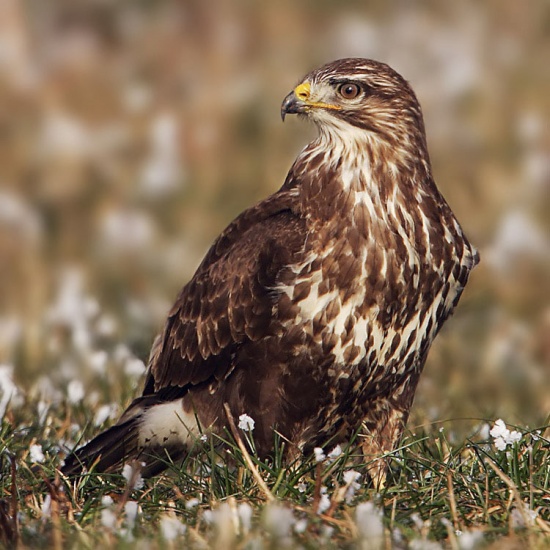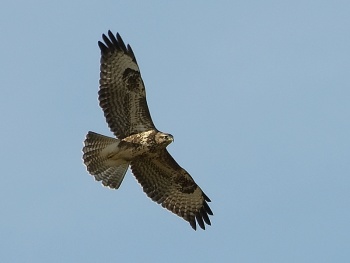Alternative name: Eurasian Buzzard
Includes Cape Verde Buzzard; (Western) Steppe Buzzard
- Buteo buteo
Identification
50-56cm.
- Variable plumage from pale brown to dark brown
- Pale breast band
- Barred tail
- White patch on underside of wing
Distribution
The Common Buzzard has a very wide range, breeding in Europe and Asia and several Atlantic islands.
The species is partly migratory, with some birds wintering as far south as Africa south of the Sahara.
Taxonomy
About eleven subspecies are currently recognized. Often mentioned is the Steppe Buzzard B. b. vulpinus, an eastern European to northern Asian form in which some members are recognizably different from nominate European birds. No major authorities currently recognize this as a full species, even though reports to the opposite effect can be found on the internet.
Subspecies[1]
- B. b. buteo:
- Western Palearctic region and Madeira; winters to western Africa
- B. b. arrigonii:
- B. b. rothschildi:
- B. b. insularum :
- B. b. bannermani:
- B. b. vulpinus:
- Northern Palearctic; winters to southern Asia and Africa south of the Sahara
- B. b. menetriesi :
- Southern Crimea and Caucasus to northern Iran
- B. b. japonicus:
- B. b. refectus:
- B. b. toyoshimai:
- Izu Islands and Bonin Islands
- B. b. oshiroi:
- Daito Islands
Habitat
Forests, scattered woodland and moorland also increasingly urban edges. Likes hilly areas to provide thermals.
Behaviour
Diet
The diet includes rabbits, rodents, ground birds, reptiles and carrion.
Breeding
Their nest is built from sticks and foliage, sited high up in a tree or on a cliff edge. The 2-3 eggs are incubated by both sexes for 33-36 days; the young fledge about 43-50 days later.
Vocalisation
Call: high-pitched mewing.
<flashmp3>Buteo buteo (song).mp3</flashmp3>
Listen in an external program
References
- Clements, JF. 2008. The Clements Checklist of Birds of the World. 6th ed., with updates to December 2008. Ithaca: Cornell Univ. Press. ISBN 978-0801445019.
- BBC Science and Nature
- BF Member observations
Recommended Citation
- BirdForum Opus contributors. (2024) Common Buzzard. In: BirdForum, the forum for wild birds and birding. Retrieved 3 May 2024 from https://www.birdforum.net/opus/Common_Buzzard
External Links





